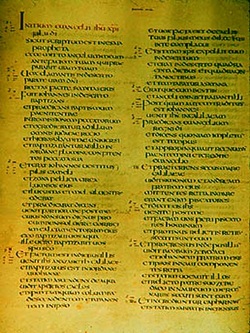- Fragments Iirejected Scriptures Reading
- Fragments Iirejected Scriptures Study
- Fragments Iirejected Scriptures Definition
An agraphon is a saying of the Lord that was not written down.It is a somewhat unfortunate term, since obviously the saying was written down at some point, else how could we know about it?What is actually meant by the term is that the saying was not written down in the canonical gospels.Also included in this list are several that are attributed, not to the Lord himself, but to some unknown.
- The Oracle of the Potter is a Hellenistic Egyptian prophetic text, originally written in Demotic Egyptian in the 3rd century BC. However, there are only five remaining Greek manuscript copies of the document on papyrus (parts of two manuscripts were rewritten, likely in the 2nd century BC following the failed rebellion of Harsiesis in 132-130 BC) dated to the 2nd or 3rd centuries AD during the.
- Reuben is the executive producer of Faithlife TV/Faithlife Films. An experienced commercial director and documentary filmmaker (Reunion, Archaeology + Jesus, Aliens & Demons), he lives in Bellingham, WA with his wife SaraAnn and their children.
Remember the discovery of the “Jesus tomb”? The “crucifixion nails”? Noah’s Ark? Each of these supposed finds was at the center of a brief but intense media frenzy in recent years. These discoveries, often suspiciously timed around major Christian holidays like Easter, might prompt interesting discussions about the historical reliability of the Bible, but rarely turn out to be legitimate archaeological finds.
A fragment of a writing ascribed to Mani, in Sogdian and Persian 1 The most Beloved Son, the Savior Jesus, the head of all these gifts, Who is a refuge for the holy and a blessing for the wise, is exalted. Overview System Requirements. HoloLens Description. A mysterious group comes to you for help. As a detective gifted with the unique ability to investigate crimes based on memories, you'll examine holographic crime scenes and gather clues blended into your reality. Use your wits and cutting-edge tools to solve.
Christianity Today is reporting on another recent (possible) discovery of special interest to Christians: an alleged early fragment of the Gospel of Mark. Daniel Wallace, the professor at Dallas Theological Seminary who earlier this year announced the find, claimed during a debate that the fragment is the earliest known New Testament text. (You can read Wallace’s account of the debate and the surprising announcement at the Parchment & Pen Blog.)
This would certainly be exciting news if it’s confirmed. However, the CT article describes the very cautious reaction this announcement has received from scholars:
Fragments Iirejected Scriptures Reading

Other New Testament scholars won’t get a chance to study this gospel portion until it is published in a book about a year from now. They are admittedly skeptical, since the alleged fragment would be almost two centuries older than the current oldest copy of Mark….
“I won’t believe it until I see it,” said Simon Gathercole, editor of the Journal for the Study of the New Testament at Cambridge University in the United Kingdom.
Peter Head, a New Testament research fellow at Tyndale House, a British residential center for biblical research, is likewise eager to get a look at the fragment before rendering an opinion….

Biblical scholars are increasingly frustrated with sensational finds, often announced during the Christmas and Easter seasons. Magazines, book publishers, and cable channels seem more interested in pumping up sales and viewers than in assuring that discoveries stand up under scholarly scrutiny.
Healthy skepticism seems like a reasonable response to sensational claims—better to wait for a scholarly consensus before splashing the news across magazine covers. If the find is genuine, it could add significantly to our understanding of the New Testament and its formation… but let’s make sure it’s true before we get too excited.

Fragments Iirejected Scriptures Study
This is a topic that we’ve discussed at times in the past—see our earlier post about how to respond to sensational archaeological claims. For more specific reactions to the Mark fragment announcement, see some helpful words of caution at The Biblical World.
Fragments Iirejected Scriptures Definition
Related posts:
